The Biology of the Goat
Lactation in the goat - Milk production
Alveoli are the milk producing structures of the mammary gland.

Each alveoli has a rich supply of blood that bring the components of milk to the cells.
Capillaries bring components that make up milk.
Venuoles remove excess fluid.
About 500 volumes of whole blood must pass through the udder to make 1 volume of milk.

The lining of each alveolus is composed of cells that surround a cavity called the lumen.
Epithelial cells surround the alveolus.

The epithelial cells of the alveoli act like factories that have 3 functions in milk production.

The epithelial cells, like all cells, require energy to do the work.

One product of fermentation by the microbes in the rumen is propionic acid.
Propionic acid is absorbed into the blood stream and transported to the liver where
it is converted to glucose.

About half of the glucose absorbed is used as a source of energy for the cell.
The other half is used to make lactose.

Acetic acid is the major by-product of fermentation by rumen microbes.

Glucose and acetic acid are used to create energy for the cell's use.

Second, the epithelial cells of the alveoli need to synthesize (manufacture) components of
milk that are not found in the blood such as lipids (fats), most of the protein, and lactose.
The cells also control the number of molecules of each component that is secreted in the milk.

The synthesis of milk fats is called lipogenesis.
Milk fats are manufactured by the alveolar cells from precursors brought by the blood.
A fatty acid is a molecule that has a short or long chain of carbon atoms with this structure on the end.
Acetic acid is a very short chain fatty acid.
Because it evaporates it is called a volatile fatty acid.

Acetic and b-hydroxybutyric acid, which are products of rumen fermentation,
are precursors of fatty acid synthesis in the mammary gland.

In a complicated series of steps, acetic acid in particular is combined to create
a long chain fatty acid called palmitic acid. Palmitic acid has 16 carbon atoms in a chain.

Palmitic acid can be used to synthesize fat or it can be broken down into
shorter chain fatty acids such as capric acid (Capric acid has 10 carbons in the chain)
which is present in a high amount in goat milk.

The percentage of fats in milk is influenced by nutrition and environment.
A fat is created when three fatty acids attach to a glycerol molecule.
The result is called a triglyceride, the most common type of fat in milk.

There can be a great variation in percentage of fat in milk in different species
and between indivduals within species.
This is long chain triglyceride.
Goat and cow milk have a higher percentage of shorter chain triglycerides than human milk.
Colostrum has a higher percentage of fat compared to normal milk.
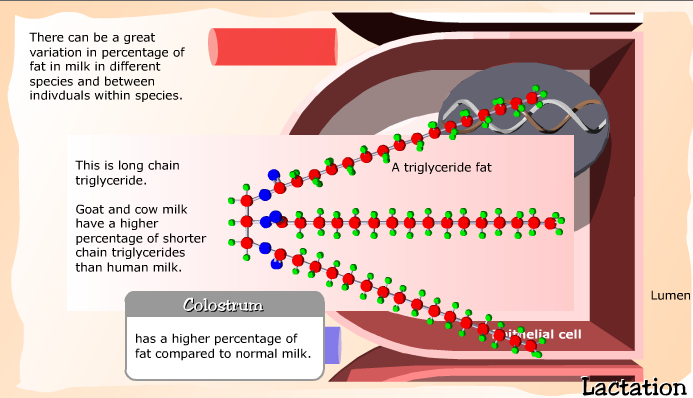
Milk Protein
Proteins are made from amino acids.
The genes in the nucleus of the cell direct the types of proteins created.
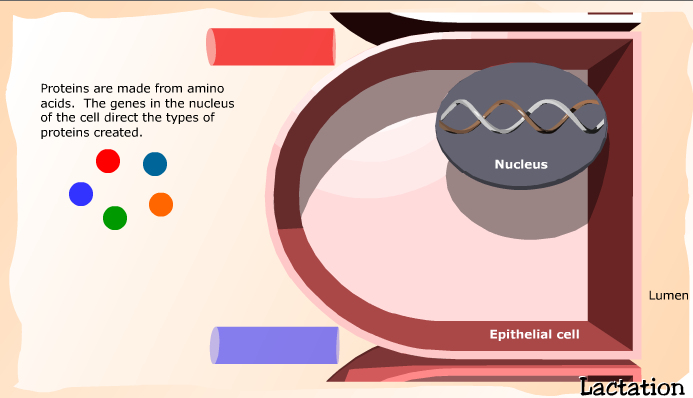
There are 20 different amino acids which are the end products of intestinal digestion
of proteins (the goat can make some amino acids)

Amino acids are absorbed through the intestinal wall, transported by the blood to the liver
which directs them to body tissues as needed.

The genetic material (DNA) in the cell nucleus directs the type of protein made from the
amino acids by creating a template (messenger RNA).

Each type of protein has a specific order of amino acids bonded together in long chains.

Casein proteins are the major type of protein in milk. [view casein protein images here]

b-lactoglobulin and a-lactalbumin proteins are synthesized only in the mammary gland.
Other proteins such as albumin and the immune globulins are synthesized elsewhere
in the body and absorbed by the cells.
The percentage of protein in milk is fairly constant within a species and between species.
Colostrum has a high percentage of protein especially gamma globulins which contain antibodies.

Lactose is the sugar of milk.
It is created only in the alveolar cells of the udder by combining glucose and galactose.

Glucose is absorbed from blood

Inside the cell some of the glucose is converted to galactose
(some galactose is also absorbed from the blood)

Galactose is very similar to glucose except for the orientation of these molecules

In a few more steps glucose and galactose are combined to make lactose.
An enzyme called lactase is required to break the bond between the galactose and glucose molecules
Colostrum has a low percentage of lactose compared to normal milk.
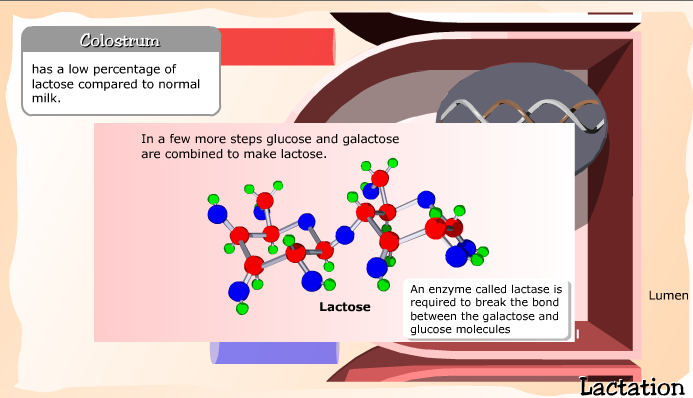
The third function of alveolar cells is to regulate the amount of components that come
directly from the blood but are not changed in the cell, such as water, vitamins and minerals.

Water flows through and between cells by diffusion.
Milk is about 87% water.

Alveolar cells regulate how much of each type of mineral is absorbed and included in the milk
Major Minerals
Calcium
Phosphorus
Potassium
Chlorine
Magnesium
Sodium
Trace Minerals
Arsenic
Boron
Cobalt
Copper
Fluorine
Iodine
Iron
Manganese
Molydbenum
Zinc

In milk, 75% of the calcium is combined with phosphorus, casein proteins and other molecules.

About 55% of phosphorus is combined with calcium and other molecules in the milk.

Major minerals and trace minerals help regulate the amount of water and maintain a normal pH
of around 6.6 in the milk as well as supply nutrition to the kid.
Colostrum is higher in calcium, magnesium, phosphorus, chlorine and trace minerals
and lower in potassium.

Vitamins
Some vitamins are synthesized by bacteria in the rumen.
Others are converted from provitamins and precursors in the liver, small intestine
and skin or come directly from feed sources.
No vitamins are synthesized in the mammary gland.

Vitamin A
Carotene precursor comes from plant diet.
Converted to vit A in the wall of small intestine.
Stored in liver. Goat milk contains no carotene precursor like cow's milk.
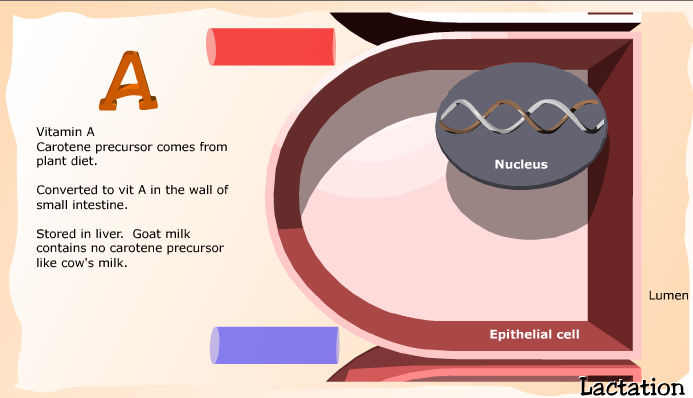
Vitamin D
comes from exposure to the sun and from plants that contain the precursor.

Vitamins E and K
E related to feed. More in green feed, stored in liver. Only small amount in goat milk
Low levels of K, synthesized by bacteria in rumen and intestines.
Diet does not affect level of K in milk.

B vitamins synthesized by rumen bacteria.
Bacteria that pass through to the intestine are broken down and the goat can then use the B vitamins.
Level of B-vitamins not affected by diet with the exception of riboflavin (B2).

Vitamin C
Ruminants and all other animals except man and guinea pigs, synthesize vitamin C in their bodies.
Diet has no effect on level in milk in ruminants.

Colostrum contains a higher level of all vitamins, especially high in vitamin A for immune protection.
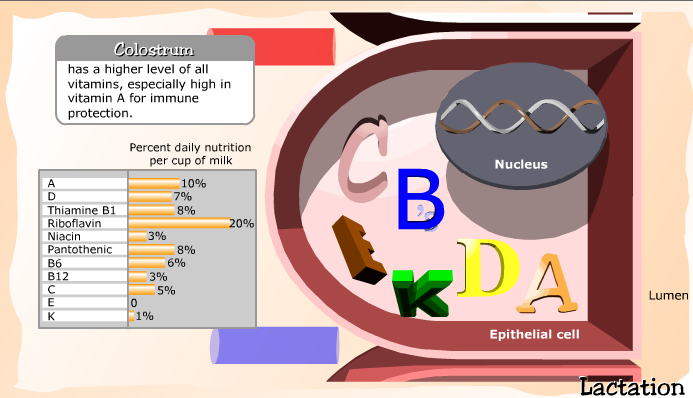
Once all of the milk components are manufactured in the cell or selected from the blood supply
they are secreted from the cell into the lumen of the alveoli.
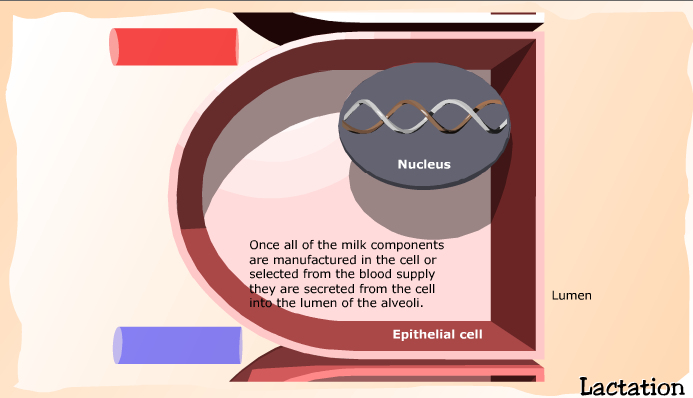
Fat and other components flow through the membrane of the cell without disrupting the cell.
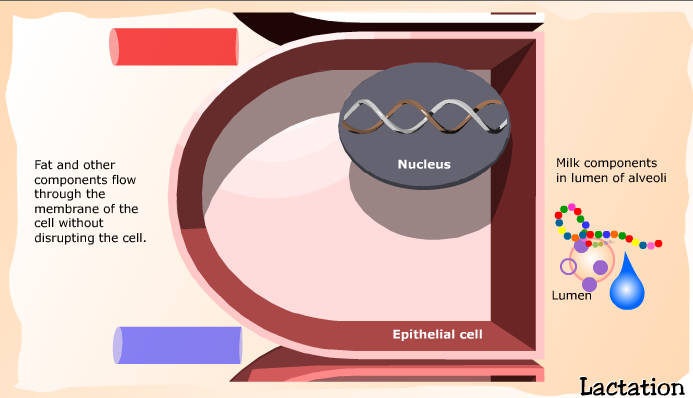
Composition of Goat Milk
Fat 3.2%
Minerals 0.64%
Total Protein 3.4%
Lactose 4.7%
Water 88%
Plus vitamins, epithelial cells and leukocytes (white blood cells which include neutrophils, eosinophils, macrophages and lymphocytes)
